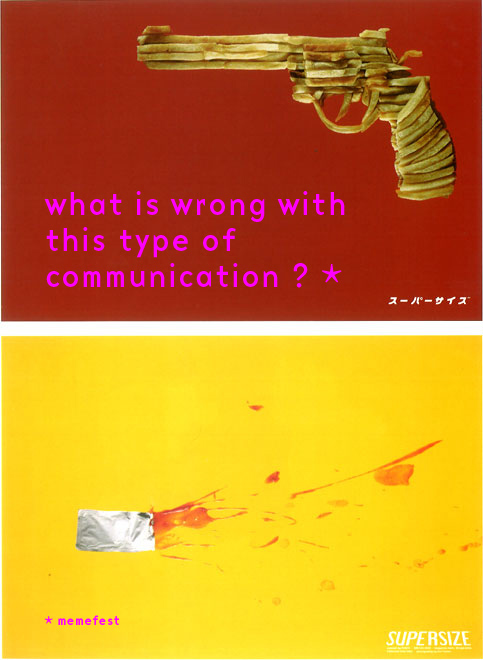Memefest Awards- Mapping Socially Responsive Communication Workshop

This might come as a surprise, but most of so called »socially engaged« communication is either not effective or even counterproductive. Why? The main reason is that such communication is conceived in the same way as marketing communication for a product or service. The difference is content, but the perspective from which such communication starts and the dynamics it produces in the public sphere are pretty much the same.
When it comes to visual communication, the ideological trap lies in the nature of the image as a cognitive product of our spectacle based culture. Communication is perceived on the level of the image surface. Extracted formal surface.
Social problems are treated as products and communications solution to this problems are treated as products as well. Most of this communication would officially fall under the umbrella term of »social marketing«. This means a specific perspective through the lens of the market is employed for solving social issues. But can we use the exclusive perspective of the market to solve social problems with communication?
Lets take this example. It tells us that French fries (or fast food) is bad for us. But people know that already very well. So…if they know it- why do they keep eating it? This is a simple but representative example of whats wrong with this picture. The problem is deeper. But the communication »solutions« suggests to stay on the surface.
There is hundreds of communication examples, designed on the same principles as our example here, which are awarded, praised and taught about and shown on conferences, festivals and at universities. Such communication work does not change anything, but it makes the impression that things are getting changed. It creates a surface image of change instead of real change through (visual) communication.
If communication should influence dominant memes, we should first think about reasons for certain behavioral and cognitive patterns. The reasons are complex and different. To some extent they are mainly ideological- and here we come to the next step of the problem. How can we as communicators together reflect on the dominant (market driven) ideology of communication if this is the DNA within most of the University communication and design programs, within the professional institutions such as advertising agencies and design studios? How can we practice communication that goes beyond the commercial perspective for social issues?
Memefest is researching this issues thoroughly for the past eight years. One of the most fascinating observations to me is that within the professional design and broader professional communications community this aspect of communication is almost completely ignored. A total blind spot. I can observe this among students, among designers- also (or especially) among design super stars and while co-directing my own communications studio i can see this type of perception regularly among clients.
So here is the idea:
AS PART OF THIS YEARS MEMEFEST AWARD, TWENTY CHOSEN AUTHORS OF BEST FESTIVAL SUBMISSIONS WILL BE INVITED TO PARTICIPATE IN A SPECIAL MEMEFEST-SOCIALLY RESPONSIVE COMMUNICATION WORKSHOP IN NIJMEGEN, NETHERLANDS IN JUNE 2011, IN COLLABORATION WITH ODDSTREAM FESTIVAL. ALL COSTS COVERED.
What we will try to do is to produce visual maps which will show the differences (and reasons for them) between Socially Responsive Communication and »social marketing«.
Workshop will be mentored by some of the best radical communicators in the world. We will also try to experiment with the workshop format and dynamics in order to make this the most productive, creative and satisfying experience possible.
How does this sound to you?
Let's see what will happen. Have a good new year, you take care!
Read more about Memefest awards:
http://www.memefest.org/en/competition/awards/
Participate in Friendly competition and get a chance to be invited to the workshop:
http://www.memefest.org/en/competition/intro/
Read more about this subject in our new book:
http://www.memefest.org/demonstratingrelevance/en/
Image taken from Design for Dissent (Glaser Milton & Ilić Mirko editors)

Comments
14 years, 5 months
14 years, 5 months
14 years, 5 months
Yes, check out the first three reports by Tom Crompton: http://www.wwf.org.uk/what_we_do/campaigning/strategies_for_change/
You can also see his website:
http://www.identitycampaigning.org/about/
The reports describes how environmental communications stuck within this 'social marketing' strategy are not only failing to have the desired impact, but are perhaps even reinforcing values that are anti-environmental. Social marketing remains fixed on the market as the dominant from of reference. So it won't challenge the dominance of today’s materialistic values. Tom Crompton seems to stops short of a critique of the market itself (and the way most NGOs believe that challenges must be meet through the market - i.e. more green products or maybe carbon trading), but his critique of social marketing is a good starting point, especially for WWF which is normally a very conservative NGO.
14 years, 1 month
A couple of years ago I would ask someone what kind of design he or she does and I would get an answer such as: " I am Stuff Designer".
Designers used to, and some still define their practice by the medium they use. For 'stuff' you could therefore fill in any field such as industrial-, fashion-, web-, interactive-, communication-, graphic- and so forth.
After a period of complains about the democratization of design and the fact that "Everyone is a designer" all of those different fields seem to be put in an interdisciplinary melting pot and are now coming out in new shapes.
Now I read designers are Thinkers who develop Strategies. They do Research. Designers are Social, consider Process as design, create Systems. They are Do-Gooders and are all about Participation. Designers are Sustainable and designers want Change.
The medium became secondary. The attitude and approach got relevant instead.
Hence it seems easy. If you are considering a design practice pick one of those terms, place it in front of –Design, and there you go.
But looking closer to those terms one will realize, it is hard to disagree with them. All of those terms actually mean everything but nothing at the same time. So from what I experience in my work surrounding it seems those terms are sold as marketing strategies.
14 years, 1 month
What you are describing can be observed in other countries too. Design as a profession is pretty much clueless what to do. It somehow knows that there needs to be a big step made towards concept, theory, interdisciplinary, research, critique, sustainability, social responsibility etc.. but only very rare designers or institutions make a radical enough step to avoid the trap of cooptation. Its interesting to look at design education institutions. Most of the start branding them selves as environments that provide innovative insight about "ethics", "social change", "sustainability"...
I don't think it is only a bad development. Not so long ago, almost no one spoke about this, now its part of the agenda. What will be important is role models, examples of projects, institutions, initiatives that will articulate their common vision through design/communication practice as well as through theoretical practice outside of close circles within academia or activism. Practice that will be radical enough to avoid cooptation. A new network of people with integrity could start this. What if we use the opportunity of Memefest workshop and strategize about this issues too?
Also, looking forward to your opinion on this:
http://www.memefest.org/en/memeblog/2011/05/mapping-socially-responsive-communication-workshop-preparation----case-study-faculty-of-arts-university-of-ljubljana-humanites-in-a-selfimposed-crisis/

To comment, please create a Memefest account, it will take you only 2 minutes! Login here if you already have one.